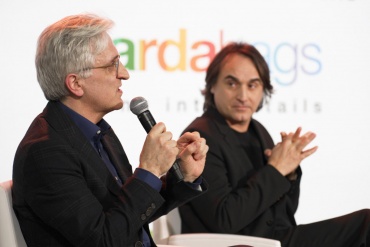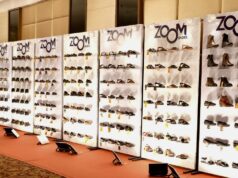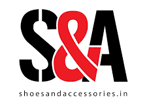It is no longer possible to talk about sustainability using verbs in the future tense. While this has been the case up to now, the new European regulations that have recently come into force, and the many others currently in the pipeline, are forcing the business community to become more and more committed. It is time to move from thought to action.
Sustainability, and in particular traceability, was once again discussed during the 98th edition of Expo Riva Schuh & Gardabags, in a Talk that brought together important representatives of the sector who have been working on these issues for some time. Deborah Taylor, managing director of the Sustainable Leather Foundation and consultant for Europe of the United Nations Economic Commission, as well as former director of the Leather Working Group for five years. Massimo Brandellero, founder and CEO of The ID Factory, a collaborative platform that maps the entire supply chain through the creation of digital IDs; Manfred Junkert, managing director of the Federal Association of the German Footwear and Leather Goods Industry.
On the subject of the new European regulations dedicated to sustainability and traceability issues already transposed by France and Germany: how are they changing the European production landscape and what prospects are they opening up for the world of production?
THE STAGES OF SUSTAINABILITY AND TRACEABILITY
The issue of traceability is the first crucial point to focus on if one wants to act sustainably, according to Massimo Brandellero. “Ten years ago, when the first major environmental associations protested and brought sustainability issues to everyone’s attention, brands began to investigate their supply chain, realising that it would not be easy to obtain information and transparency. The fashion supply chain, after all, is by no means built to reveal its secrets; on the contrary, it is structured to preserve and hide its know-how, because it is precisely in those techniques, skills and knowledge that the greatest added value of a manufactured product lines. Since then, however, everything has changed, says Brandellero. Everything that used to be kept secret, became necessary to share and investigate in order to be certain of the value of one’s suppliers and thus products. But until 2018, we do not see much change. It is from the following year that something begins to change, as the demands of the market become tangible and insistent (even if nothing is yet moving at the legislative level). If brands had been focusing on Corporate Social Responsibility, from that moment on, a new area of interest began to emerge and it concerned the world of materials, which involved the entire supply chain. “We realised,” continues Massimo Brandellero, “that the value chain itself generates 90 per cent of a product’s environmental, social and financial impact. From this consideration, the centrality of the traceability of the supply chain upstream of any sustainable approach was derived. Every aspect of sustainability and every thematic area cannot be separated from a transparent and traced supply chain, based on qualitative and verified data”. Today, for the first time in ten years after the first protest movements about the lack of sustainability in fashion, a change in approach to the subject is noticeable. Whereas before, sustainability was just a key value to talk about, today it means metrics, long-term projects that take into account the complexity and multifaceted nature it implies. For a couple of years now, the industry has become aware that the topic is an integral part of a company’s workflow, and dedicated departments are beginning to make a real impact on production flows.
NOW THE LEGISLATOR IS ALSO MOVING
It is Manfred Junkert who introduces the topic of the new European legislation that Germany has already adopted. The German Due Diligence Law goes back a long way: its process starts around 2011 thanks to talks with the United Nations concerning the observance of Human Rights; in 2016, Germany equips itself with a national action plan with the intention of taking concrete actions at the level of supply chains; in 2021, the draft law is ratified to become effective as of 1 January 2023. “The law stipulates that companies should progressively adopt a system for Risk Management, both environmental and social, and set up managers in charge of the supply chain. The measure primarily affects large companies, which are called upon to adapt quickly, but it will also progressively involve smaller companies”. At the moment, German companies seem particularly concerned that the new rules will entail a great deal of bureaucracy, as well as an additional cost. Above all, they fear that they will be forced to disclose the composition of their supply chain, which is often their main competitive weapon on the market. The positive aspects, on the other hand, are linked to the mentality of the companies, which are increasingly driven and convinced that working towards sustainable production is necessary. What are the points that manufacturers need to clear quickly in order to continue selling in Germany? Junkert answers: “If you have large German customers, for whom the new regulations apply as of now, you may be asked to report to your suppliers on the risks they are exposed to and what solutions they have adopted to prevent them. As an association, we have just published a 20-point questionnaire to help companies identify the important points to consider”.
IS IT POSSIBLE TO TRACE SUCH A FRAGMENTED FOOTWEAR SUPPLY CHAIN?
It is well known that the footwear production chain is particularly fragmented in terms of the amount of processing and production locations. Is it realistic to think of being able to trace it? For Deborah Taylor it is difficult, but necessary to be able to trace the life of a product from its arrival in the shop back to the farms or raw materials of which it is made. “Right now, there is a lot of noise around the topic of sustainability, and this noise risks covering up the right and substantial words that should be considered: conscious production and consumption”, says Taylor. Sustainability, on the other hand, is not a box that can be ticked once and for all, but a change of mentality that questions productions day after day on how they could be less impactful on people and the environment. “A change of mentality”, continues Deborah Taylor, “that will also be driven by the various regulations that not only France and Germany are adopting, but that the whole of Europe will be called upon to adopt. I am thinking, for example, of the recent obligation for companies to present a Corporate Sustainability Report in place of the Non-financial Reporting that many large organisations have had to present to date. While for now these regulations only apply to companies in certain sectors and with more than 500 employees, within three or four years the measure will also involve small and medium-sized companies in many more areas, not just fashion”. The law does not require companies to be perfect, but to be transparent in communicating where they are located. They will have to indicate where their potential risks lie, what they can do to minimise them, and what their goals are. “It is essential to start taking concrete action, after all, the successful business of the future is one that is prepared today”.
ACCELERATING SUSTAINABILITY
It is said that the pandemic, social pressure, big brands and new laws have accelerated the implementation of concrete actions aimed at sustainability. Truth or green washing? “It is undoubtedly true”, Massimo Brandellero believes. “Let’s say that those who have not already started thinking about it have to start now, because what we have seen happen in the last 7 months, we have not seen happen in the last 7 years. We also see a deeper level of enquiries from companies, denoting that there is much more quality in the approach to the subject”. We come back to traceability to illustrate the point: if until a few years ago brands considered it necessary to trace the value chain in order to exercise control over suppliers, today they interpret transparency as an incentive to improve every aspect of production and to be able to communicate, if not today then in the near future, with their customers. This implies that it is no longer just the department responsible for dealing with sustainability that is involved in this issue, but the entire company.
WHICH FIRST STEPS A COMPANY SHOULD TAKE TO BE MORE SUSTAINABLE
“This is the key question we started with in the European project. We decided to set up a toolbox and standards that every organisation could adopt in order to start on the path to more sustainable production”, says Deborah Taylor. These are the steps she identifies as primary: make a clear assessment of what you know and don’t know about your workflow, then structure a risk assessment and identify the processes needed to mitigate them. “I suggest to everyone not to run away from any risks identified along the supply chain, but to work together with their partners to minimise them, so that the whole industry can grow in terms of sustainability. Also, because solutions are often found by combining different approaches, certainly not by acting as separate silos”. As far as the approach to consumers is concerned, for Taylor it is very important to carefully consider the information to be conveyed: “The consumer does not want to know the name of the animal from which the leather of a shoe is derived. He wants to be sure that the supply chain is verifiable and verified”.
TRACEABILITY MUST NOT BURDEN PRODUCERS
Traceability is often pursued by means of audits that burden the manufacturers both financially and in terms of time. An unsustainable situation in the long run. For Deborah Taylor, “standards and third-party certification audits are the best tools we have today, but they risk being impossible to sustain for companies that have to spend resources of money and time to manage the different requirements that each individual brand demands. The process must be optimised to alleviate the pressure on companies. With my foundation, for example, we have designed a Transparency Dashboard where we give an account of the certifications that each company has achieved so that each brand can access them and not duplicate their demands”. Another important point concerns standards. The large certification organisations, led by COTANCE, are working to harmonise standards so that they can identify a common one that is robust and reliable: what documents need to be exchanged, how, with what data and at what point in the supply chain to provide it. “The aim is to arrive at a new, specific ISO standard for traceability that aligns all certifiers to a shared pathway”.
FUTURE DEVELOPMENTS IN TRACEABILITY
Massimo Brandellero does not want to make fortune-teller predictions, but to analyse the movements already underway to imagine the future developments of the traceability issue: “It will be necessary, and it is already happening, to develop technologies and systems to trace the supply chains that are collaborative and can exchange information so as to avoid unnecessary duplication in this area as well, as for audits. It will be necessary to derive qualitative data from supply chains that can link and remain linked to products. Traceability, in fact, will also become necessary and functional for certain sectors that not many people think about today: in the growing rental sector of clothing and accessories, or in the increasingly frequent take-back of end-of-life products by brands (if the product carries all the information about the materials used, it will be easier to identify disposal or recycling methods). Manfred Junkert concludes: “We are in the midst of a transformation process that will find companies prepared for major changes. The increasing pressure of European legislation will lead to greater co-operation between the different trade associations, which will have to lead to the identification of a classification system for the various aspects of sustainability that will enable the consumer to confidently and easily assess the sustainable value of the products he or she buys”.










